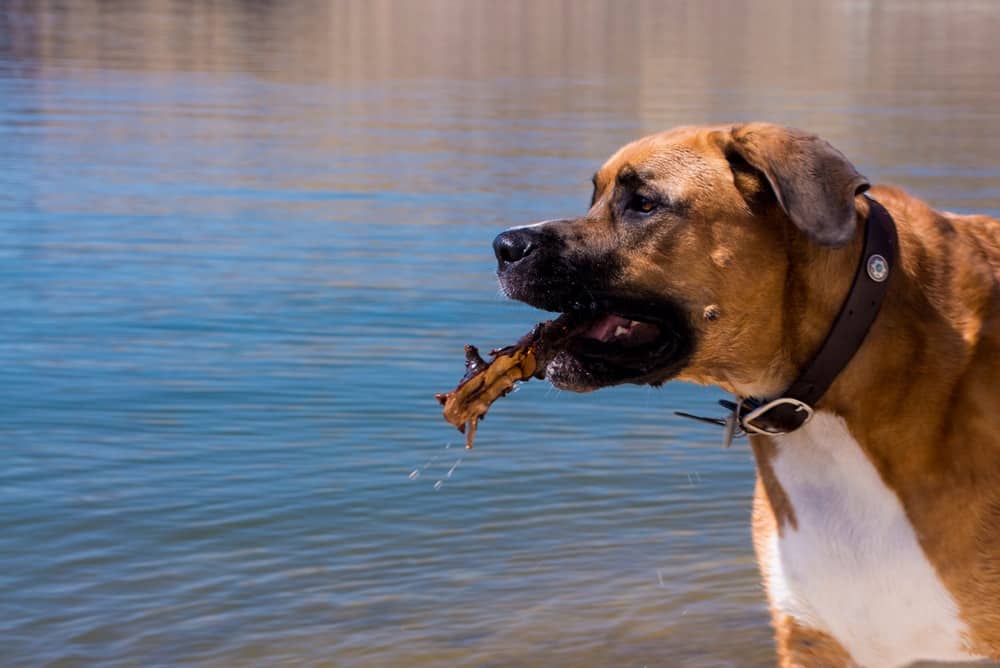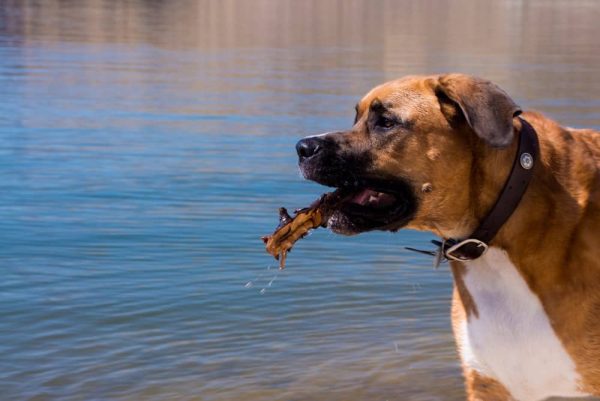Great Danes are among the largest dogs in the world. For this reason, it can actually be somewhat difficult to make crossbreeds with them. For a mix to work out safely, the dogs have to be somewhat comparable in size. Otherwise, mating just doesn’t work.
There aren’t many dogs that are comparable in size to the Great Dane, so natural mixes don’t happen often. However, some breeders artificially inseminate a female Great Done with another breed, which can create crossbreeds that wouldn’t happen otherwise.
We put together a list of the most popular Great Dane mixes out there. These dogs are often on the larger side, though most are smaller than a purebred Great Dane.

The 16 Popular Great Dane Mixes
1. Giant Danesky (Siberian Husky x Great Dane Mix)
The “Danesky” is a mix between a Great Dane and a Siberian Husky. These dogs are often large and can weigh upward of 190 pounds. Because of how the genes work, some puppies may have the height of the Great Dane and the muscles of a Husky, which often leads to an extremely large dog.
These dogs tend to be a bit on the laidback side. While Huskies are generally somewhat active, they tend to be “40-mile-per-hour couch potatoes.” They may run intensely for a moment or two but get tired quickly. Therefore, this mix often doesn’t have high exercise needs.
This breed’s appearance varies widely. Some of them have short hair, while others have the double coat of a Husky. They may even have the markings of a Husky on an otherwise Great-Dane-looking body. You never know what you’re going to get due to the large differences between the two parent breeds. The possibilities are almost endless.
2. Plush Danois (Anatolian Shepherd x Great Dane Mix)
This mix happens when you cross a Great Dane with an Anatolian Shepherd. These two breeds of dogs are both considered “giant” breeds, which often allows them to breed naturally. Therefore, this is one of the more popular breeds on this list.
The Plush Danois can weigh upward of 150 pounds. Males are usually substantially bigger than females. These dogs may or may not have guarding instincts, depending on what traits they inherit. Regular socialization is required to prevent them from becoming aggressive toward people. The younger that you start, the better. They can be territorial toward strangers but are often understanding of their own family.
They can be good with gentle kids due to their larger size and calm nature. Of course, children outside the family may be a different matter if the dog is not socialized.
3. Great Retriever (Golden Retriever x Great Dane Mix)
https://www.instagram.com/p/BeMSwNSnF22/?utm_source=ig_web_copy_link
When you mix a Great Dane with a Golden Retriever, you often end up with an energetic and extremely intelligent Great-Dane-sized dog. These dogs can be quite a handful because they are often more energetic than a purebred Great Dane. They will often need quite a bit of exercise and regular mental stimulation, which generally takes up more time.
However, they are great for active families and those looking for a friendly exercise companion. They generally love just about anyone and don’t know a stranger. They are not appropriate guard dogs for this reason, despite their larger size. They often need to be well-trained to behave well around others, though, as their excitement can get the best of them.
This mix can weigh around 60 pounds, like a Golden Retriever, or they can weigh up to 190 pounds, like a Great Dane. It really is a guessing game. The size of a puppy at birth doesn’t necessarily indicate their size later, especially since they go through multiple growth spurts. Therefore, you should plan for a larger dog, but don’t be upset if you end up with a 60-pound one.
4. Bloodhound and Great Dane Mix
Since the Great Dane and Bloodhound are both large breeds, they can be bred naturally in most cases. They are often extremely big, weighing up to 200 pounds. Like most large breeds, males are typically bigger than females.
These dogs are often extremely laidback. They do require exercise, but not as much as you might think. They love their people and are often extremely people-oriented. They need regular attention and may be prone to isolation anxiety, which can be a serious problem due to their huge size.
Unfortunately, this mix is often not very trainable. As a hound, they simply weren’t bred to listen to people. Instead, they listen to their instincts and can function independently while on a trail. However, this independence can get the best of them as a companion animal.
5. Boxane
While Boxers aren’t as large as some other dogs, they are large enough to breed with a Great Dane in some cases. This creates the “Boxane” mixed breed.
This breed is extremely playful and energetic. They need a decent amount of exercise to thrive and often require intense play sessions and jogs. Of course, some dogs are more laidback, like their Great Dane parent. It mostly depends on what traits they inherit. These dogs can weigh up to 150 pounds, which is heavy for an energetic breed.
Their large size combined with their active nature often puts a great deal of strain on their joints. Therefore, these dogs tend to be more prone to joint problems. They simply wear down their body faster because it has to carry more weight while performing various activities.
6. Swissdane
The Swissdane is a mix between a Greater Swiss Mountain Dog and a Great Dane. Both of these breeds are on the larger side, so the mixed breed can weigh up to 190 pounds. The smallest specimens may only be 85 pounds, though.
As a working breed, this dog requires regular mental and physical stimulation. Otherwise, they can become bored and destructive. When dogs try to make their own fun, they often get into things that they shouldn’t. Digging and chewing are common boredom-relief measures.
A Swissdane will likely be more independent than a full-bred Great Dane, which often leads to training difficulties. They may learn the commands just fine but decide to make their own decisions instead of listening to their owner. It isn’t uncommon for these dogs to focus fine in class, only to seemingly forget everything that they know when at home.
Luckily, they are well-mannered as long as their needs are met, so this stubbornness may not be too much of an issue.
7. Labradane
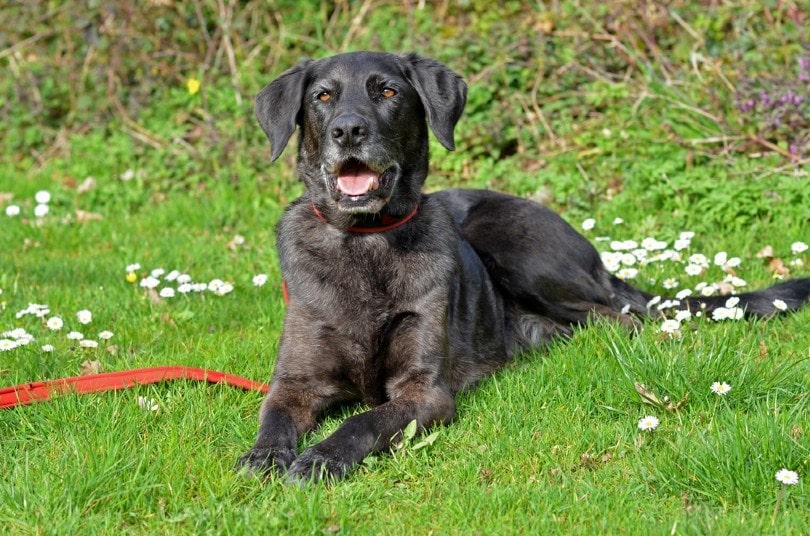
When you mix a Labrador Retriever with a Great Dane, the Labradane is the result. This dog is often friendly and affectionate. They love their people and prefer to be the center of attention. They are family-oriented and make good dogs for families with children. They are gentle and patient enough to put up with hyperactive children. Their large size means that children are less likely to injure them, which prevents fear-based biting.
They are a bit more active and energetic than most breeds on this list, though. Their large size can make it difficult to meet their needs. They need regular walks and plenty of playtime to remain happy. Otherwise, they can become bored and antsy, which can lead to destructive behaviors.
They can also be quite heavy shedders, depending on the traits that they inherit. For this reason, we highly recommend planning on grooming them often, even as much as once a day during their heavy-shedding months.
8. Dandoodle
Poodle mixes are all the rave right now. When you mix a Poodle with a Great Dane, you get a “Dandoodle” or “Great Doodle,” depending on whom you ask.
This breed often doesn’t happen naturally due to the size differences of the dogs. Generally, the Great Dane is always the female, while the male is the Poodle. Some breeders may artificially inseminate their dogs to create their breed, because mating naturally can be difficult unless you find a rather large Poodle and small Great Dane.
Dandoodles can generally reach up to 100 pounds. They are often intelligent and require regular mental stimulation. Boredom is common, especially if owners don’t really understand what they’re getting into. Training, canine sports, and puzzle toys are all recommended to keep this pooch entertained.
They typically have higher exercise needs. They are friendly, but that doesn’t necessarily mean that they are affectionate around strangers. They prefer their own people. That doesn’t necessarily mean that this breed is aggressive or territorial, as some may just ignore those who come through the front door.
9. Doberdane
Besides having the great name of “Doberdane,” the Doberman Great Dane mix has much going for it. They are an extremely loyal dog that often trains easily. They can learn many commands and will often respond quickly. This makes them a joy to train.
However, they will likely have protective guarding instincts. They can make excellent guard dogs, but early socialization is required so they know who comes through the door isn’t the enemy. Otherwise, they can easily mistake a friend for a foe. Given their 190-pound weight, this isn’t good in the least.
Puppy classes are highly recommended, though you will often have to put in even more time to their socialization. Taking them to the park and other dog-friendly places is recommended, as this will introduce them to a variety of sights and sounds.
10. American Bull Dane
A cross between an American Bulldog and Great Dane, this breed is extremely energetic and agile. They are often much more playful than a purebred Great Dane, which typically translates into higher exercise needs. They are devoted to their families and require quite a bit of attention.
They can be affectionate and like to cuddle after they’ve had a long stroll through the park. Due to their fearlessness, they can be excellent guard dogs. Many people may train them as an alert dog, as a large dog barking is often enough to scare away intruders.
These dogs can be flat-faced, which often leads to health problems. Dogs with flat faces often can’t breathe correctly, which leads to respiratory issues. Because this breed is half Great Dane, these problems are likely lessened. However, it depends on what traits that they inherit. Dogs with more of a snout are generally the healthiest options.
11. Great Dane and Saint Bernard Mix
https://www.instagram.com/p/CNdM4dih88C/
Besides the Great Dane, the Saint Bernard is another common giant breeds. Unlike the Great Dane, the Saint Bernard isn’t extremely tall but does have a significant amount of bulk. Their puppies will often be somewhere in between. Their overall size depends on what traits that they inherit from which parent. Some may be tall and lanky, while others can be short and stout. Some may even be bulky and tall, which leads to a truly massive dog.
Due to their large size, Saint Bernard and Great Dane mixes often don’t live nearly as long as other dogs. In fact, they typically only live 7 to 10 years. Their larger size simply causes their body to break down faster, leading to a shorter lifespan overall.
Their large size also makes them more expensive. They eat large amounts, which means you’ll likely be spending hundreds of dollars a year on dog food alone. They also need giant equipment, such as beds and toys. Because larger things tend to cost more, this often means that you’ll be purchasing things on the more expensive side for this canine.
12. Great Pyredane
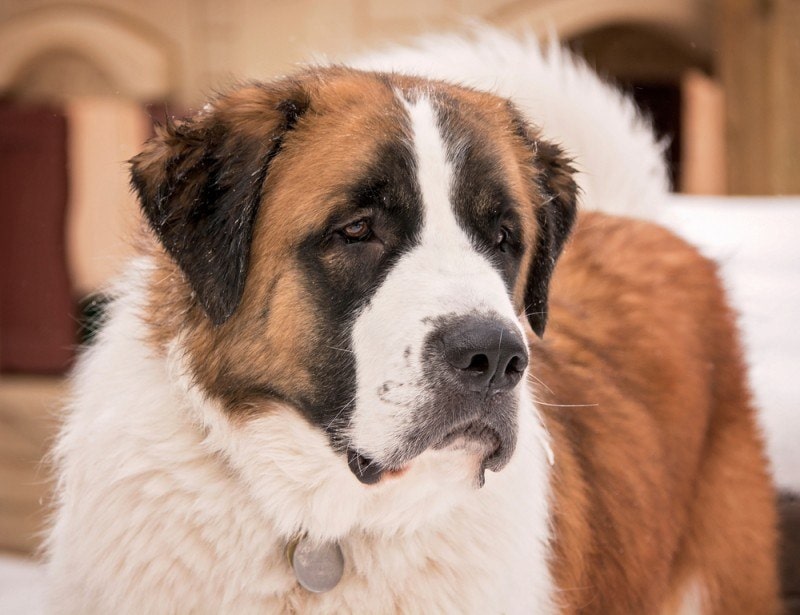
The Great Pyrenees is a large dog that can breed naturally with the Great Dane. Their mixed puppies can vary widely, as the parents differ despite their nearly identical sizes. The puppies may be fluffy or have extremely short hair. Many are heavy shedders, no matter what, though this is often more of a bother with a long-haired dog. In the same litter, you will often end up with puppies that differ widely. You really don’t know what you’re going to get.
These dogs are typically a bit independent, which allows them to spend a decent amount of time alone. Some are a bit more people-oriented, though, and may develop isolation anxiety.
While these dogs generally aren’t aggressive, the Great Pyrenees was bred to guard flocks of sheep. Their mixed-breed puppies may inherit this territorial behavior. Fortunately, early socialization can greatly lessen the effects of this protective instinct. If they are shown that not all strangers are bad, they typically won’t blink when someone new enters the home.
13. Great Dane and Rottweiler Mix
This mixed breed goes by many different names. The “Weiler Dane” is the most common but “Daneweiler” also appears quite often. This mixed dog breed is less common than most, as the parent breeds can differ quite a bit in size. Either way, the result is a dog that is quite impressive.
Generally, this breed tends to be laidback and may even make a good apartment dog. They don’t require much exercise, which is great if you’d rather cuddle with them on the couch than go for a walk.
However, they can be a bit difficult to train due to their independent attitude. They simply weren’t bred to work closely with people, so they don’t tend to listen to their owners quite as well as some dogs do. They can also be a bit protective and aloof with strangers, so socialization is recommended.
14. Daniff
Mix a Great Dane and a Mastiff, and you often end up with a rather lazy but protective canine. Mastiffs were originally guard dogs, so the Daniff often has at least a few guarding instincts. However, the extent can vary widely. Some dogs may be more laidback, like the Great Dane. Either way, early socialization and training are required to teach this mixed dog that not all people are bad. Once they become used to having strangers around, they often won’t feel so threatened when one comes into the home.
This dog can be huge. Some are reported as weighing more than 200 pounds. Be sure you have room for this dog before you adopt them. While some do fall closer to 100 pounds, it is impossible to know how large a puppy will be when they are fully grown.
Daniffs have moderate exercise needs. A quick walk is often all that is required. They will spend most of their time lying around. They don’t require much grooming, though they can shed quite a bit. Their extremely short hair is easy to take care of, so they often only need to be brushed about once a week or so.
This breed is often stubborn and difficult to train. Most will make their own decisions in the heat of the moment instead of listening to their owner. This is simply how they were bred.
15. Great Shepherd
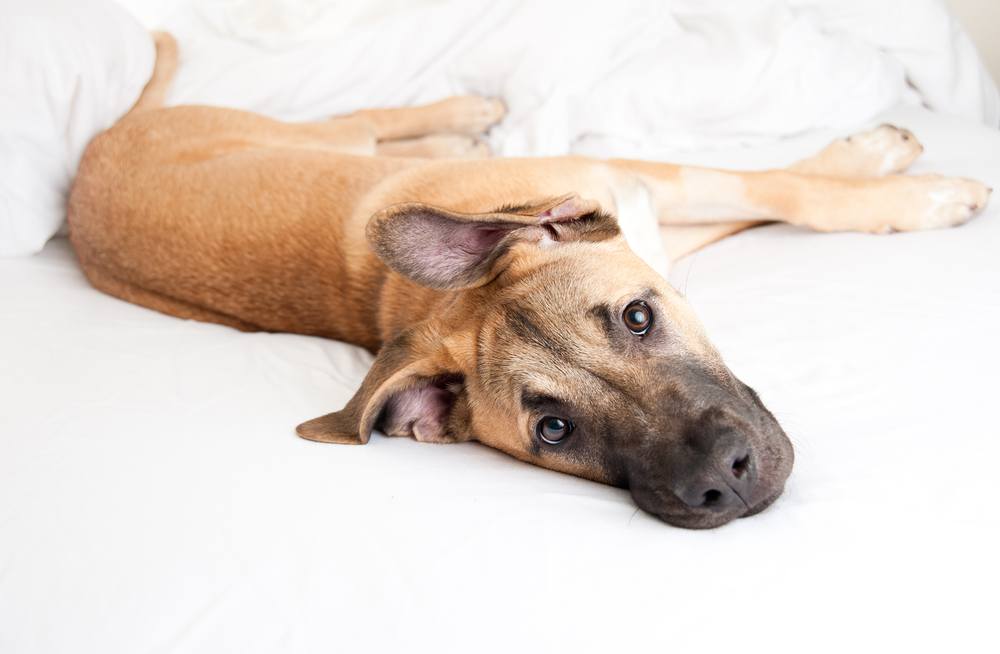
A Great Shepherd is a mix between a German Shepherd and a Great Dane. These dogs can be a bit of a handful. German Shepherds often need extensive training and socialization because they are untrusting of strangers. There is a reason that they are often used for police and military work. The Great Dane can dampen down this aggressiveness, but the puppies will still require socialization and training starting at a young age.
Usually, these dogs weigh around 100 pounds. They can get up to 190 pounds, though, so plan accordingly. Females are usually substantially smaller than males. If you want a smaller dog, get a female.
These dogs are often dedicated and can make wonderful family dogs. They are patient with people. Their large size allows them to be fearless around smaller kids who may not know exactly how to act around dogs.
16. Danebull
The “Danebull” is a mix between an American Pitbull Terrier and a Great Dane. These dogs are extremely energetic and can even be hyperactive. They require quite a bit of exercise for this reason. They’re basically giant terriers.
They aren’t particularly aggressive, despite common misconceptions. They are extremely loyal and affectionate with just about everyone. They aren’t too wary of strangers, though regular socialization is still recommended. They do require a decent amount of training, as they don’t always have good house manners when left to their own devices. They tend to be eager to please, which can make them much easier to train.
Out of all the dogs on this list, the Danebull is probably most likely to knock someone down. They are simply excitable and may run into someone without even noticing. Luckily, they tend to grow out of this as they age, but it is one reason that we highly recommend training from an early age.

Final Thoughts
Technically, you can make a Great Dane hybrid with any other breed. However, larger mixed breeds are most common, as these are the only ones that the Great Dane can naturally breed with. While most of these mixes are on the larger side, it is important to remember that genetics are complicated. You never quite know what you’re getting with a mixed breed.
For instance, if you’re considering purchasing a Great Dane German Shepherd mix simply because you want a larger German Shepherd, it is important to realize that the puppy may not be much bigger than a German Shepherd at all (or it could be huge). You just won’t know until the puppy is fully grown.
Many dogs on this list are friendly and make great pets. Others are more suitable as guard dogs. No matter what Great Dane mixed breed you choose, though, you have to accept the mysteries that often come from adopting a mixed breed.
- Next on your reading list: Male vs. Female Great Danes: What Are the Differences?
Featured Image Credit: Phoebe Heideman, Shutterstock
Contents
- The 16 Popular Great Dane Mixes
- 1. Giant Danesky (Siberian Husky x Great Dane Mix)
- 2. Plush Danois (Anatolian Shepherd x Great Dane Mix)
- 3. Great Retriever (Golden Retriever x Great Dane Mix)
- 4. Bloodhound and Great Dane Mix
- 5. Boxane
- 6. Swissdane
- 7. Labradane
- 8. Dandoodle
- 9. Doberdane
- 10. American Bull Dane
- 11. Great Dane and Saint Bernard Mix
- 12. Great Pyredane
- 13. Great Dane and Rottweiler Mix
- 14. Daniff
- 15. Great Shepherd
- 16. Danebull
- Final Thoughts

